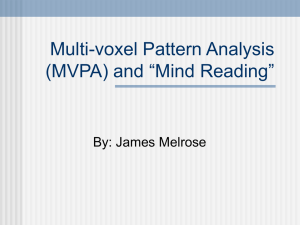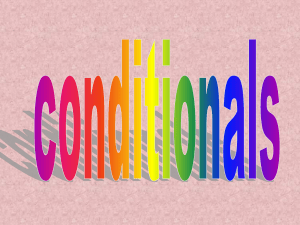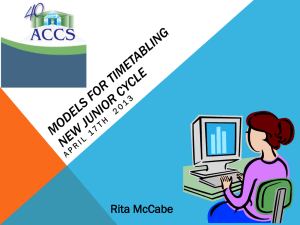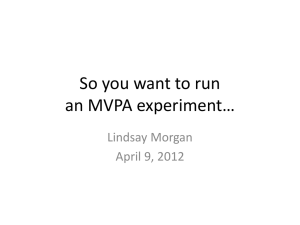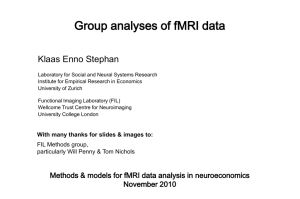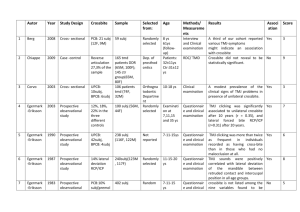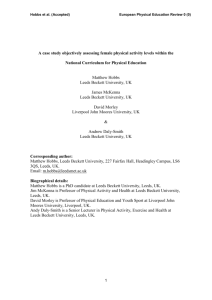MVPA
advertisement
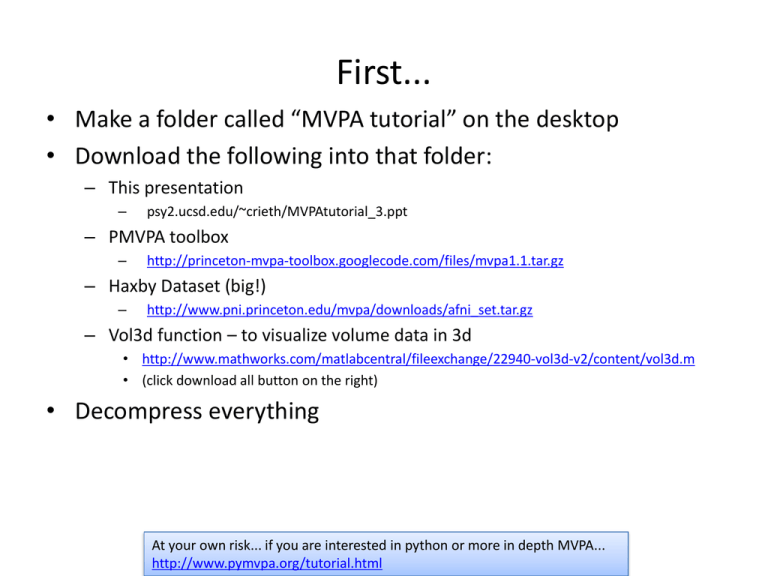
First...
• Make a folder called “MVPA tutorial” on the desktop
• Download the following into that folder:
– This presentation
–
psy2.ucsd.edu/~crieth/MVPAtutorial_3.ppt
– PMVPA toolbox
–
http://princeton-mvpa-toolbox.googlecode.com/files/mvpa1.1.tar.gz
– Haxby Dataset (big!)
–
http://www.pni.princeton.edu/mvpa/downloads/afni_set.tar.gz
– Vol3d function – to visualize volume data in 3d
• http://www.mathworks.com/matlabcentral/fileexchange/22940-vol3d-v2/content/vol3d.m
• (click download all button on the right)
• Decompress everything
At your own risk... if you are interested in python or more in depth MVPA...
http://www.pymvpa.org/tutorial.html
fMRI
functional Magnetic Resonance Imaging
Magnetically aligns spin of protons
Disrupts alignment with a short RF burst
Can use this to detect differences in tissue
BOLD signal
voxels: individual elements
of resulting signal
TR – one time point, ~2secs
Activation of 1 voxel over time
•
fMRI analysis
– Block or event designs
– Basically linear regression
model, test significance of
experimental conditions
taking into account drift and
lag
– Treats voxels as independent
outside of correction of p
values for multiple
comparisons
adapted from:
SPM Short Course
blue =
data
black =
mean + low-frequency drift
green = predicted response, taking into
account low-frequency drift
red =
predicted response, NOT taking into
account low-frequency drift
Multi-Voxel Pattern Analysis
• Consider patterns of activation
– Classify condition based on activation pattern
– Which voxels are important for classification?
– Predict what brain is doing
Haxby et al 2001
Using the classifier to predict behavior
Category-Specific Cortical Activity Precedes Retrieval
During Memory Search (Polyn et al. 2005)
Measuring brain similarity
Kriegeskorte et al. 2008
Brain reading
Using visual stimuli and fMRI
responses build a response
model for each voxel
(Kay et al, 2008)
Using this model, potential
choice images, and fMRI
response to an image, predict
image generating the fMRI
signal
More brain reading
Train a model to predict contrast images from voxel responses
Reconstruct source image from fMRI data
Miyawaki et al. (2009)
Nishimoto et al 2011
Today's objectives
• Get hands dirty with some basic MVPA
–
–
–
–
–
Build confidence in Matlab/programming/exploring code
Understand the tutorial code
Understand the importance of cross-validation
Classify between conditions
View fMRI data in matlab
Super bonus round!
– Try different classifiers
– Examine learned classifier
– Measure voxel importance
Using Princeton Multi Voxel Pattern Analysis
Toolbox
If interested in MVPA, it is worth reading through their
toolbox tutorial in more detail
https://code.google.com/p/princeton-mvpatoolbox/wiki/TutorialIntro
3d Voxels x time (TRs)
At each TR one of 8 categories was shown
Going to train a neural network to predict which category
goes with each TR
...
...
Haxby et al 2001
• Make sure the files are downloaded and decompressed
• Open Matlab
• Add PMVPA to the Matlab path
(Tells Matlab where the tutorial functions are)
– File -> Set Path... click “Add with Subfolders...”
– Select the “MVPA tutorial” folder you made
– Click “Open”
– Click “Save” the “Close”
• Open: Desktop/MVPA toolbox/mvpa/core/tutorial_easy.m
• Change directory to: Desktop/MVPA toolbox/working_set
• (To really understand what is going on, it is worth reading
through the tutorial code and website explaining it)
• For now, on the command line, type:
[subj results] = tutorial_easy()
This will run the tutorial code, which loads in 10 session of data, masks
the patterns to only include IT, preprocesses the data, trains a neural
network to classify the different categories using cross validation, and
stores the results in a variable called... wait for it... results.
(Matlab will print out a number of warnings, ok to ignore for now)
• The average accuracy is given in
results.total_perf
• Is this accuracy ‘good’? What is chance?
Error
Importance of Cross validation
Test set error
Training set error
Training
Cross validation is a technique to prevent over-fitting of models
Models can “learn too much” about a specific data set, so it looks like they are doing well, when in
reality they are only learning the peculiars of that dataset, and not aspects that generalize. Imagine
taking a practice GRE test so many times you have memorized the answers... this will do great on the
practice test, but won’t be helpful on the real test.
Instead of estimating model accuracy from how well the model performs on training data, you want to
estimate model performance based on some hold out data
Typically in cross validation you split up the training data into sections, train with all but one section,
test on the held out section, then repeat with a different hold out set
Figure adopted from: http://documentation.statsoft.com/STATISTICAHelp.aspx?path=SANN/Overview/SANNOverviewsNetworkGeneralization
Visualize Mask
• Use vol3d to visualize the mask
you were using as a volume
h = vol3d('cdata',get_mat(subj,'mask','VT_categoryselective'),'texture','3D'); %does the work, rest
makes it pretty
view([0,30,160])
axis tight; daspect([1 1 .4])
set(gcf, 'color', 'w');
alphamap('rampup');
alphamap(.6 .* alphamap);
Note: using vol3d isn’t going to be pretty, in
practice you would want to write out a file
to view in your favorite MRI software
View the whole brain!!
This part is mostly just for fun.
• Load whole brain mask
subj = load_afni_mask(subj,'wholebrain','wholebrain+orig');
• View the mask using vol3d
h = vol3d('cdata',get_mat(subj, 'mask' , 'wholebrain'), 'texture' , '3D');%add the
extra code from last slide to make it prettier.
• Reload the patterns in using the whole brain
for i=1:10
raw_filenames{i} = sprintf('haxby8_r%i+orig',i);
end
subj = load_afni_pattern(subj,'whole_epi','wholebrain',raw_filenames);
• Use vol3d to visualize the whole brain signal for 1 TR
time = 1;
pattern = get_mat(subj,'pattern','whole_epi');
volPattern = get_mat(subj,'mask','wholebrain');
volPattern(volPattern==1)=pattern(:,time);
clf; h = vol3d('cdata',volPattern,'texture','3D');
Can adapt this into a for loop
incrementing time and make a
movie...
Improving the data further
• Account (roughly) for hemodynamic lag
– Add at line 76:
subj = shift_regressors(subj,'conds','runs',2);
• Eliminate rest TRs
– Add at line 77: subj = create_norest_sel(subj,'conds_shifted2');
– Change ~line 80 to:
subj = create_xvalid_indices(subj,'runs',
'actives_selname','conds_sh2_norest','new_selstem','runs_norest_xval');
•
Update the rest of the code to use the new data
– Change ~line 86 to:
[subj] = feature_select(subj,'epi_z','conds_sh2','runs_sh2_norest_xval');
Change ~line 98 to:
[subj results] =
cross_validation(subj,'epi_z','conds_sh2','runs_sh2_norest_xval','epi_z_thres
h0.05',class_args);
Rerun. How much does this improve accuracy?
Calculating accuracy for each category
Which category is the best? worst?
niterations = length(results.iterations);
ncategories = 8;
confusionMatrix = zeros(ncategories , ncategories , niterations );
for i = 1:10
mat = crosstab(results.iterations(i).perfmet.desireds,
results.iterations(i).perfmet.guesses);
if size(mat,2)~=ncategories %needed in case the model does not respond to a
category
confusionMatrix(:,1:size(mat,2),i) = mat;
else
confusionMatrix(:,:,i) = mat;
end
end
diag(sum(confusionMatrix,3))./sum(sum(confusionMatrix,3),2)
condnames = {'face','house','cat','bottle','scissors','shoe','chair','scramble'};
Try different classifiers
• Adding a hidden layer to the classifier
– Change the number of hidden units set ~ line 94 (class_args.nHidden = 0;)
• Changing the classifier, ~line 92
class_args.train_funct_name = 'train_bp';
class_args.test_funct_name = 'test_bp';
Change ‘_bp’ (backprob) to another option for a different classifier. Also can play
with other classifier parameters (see function docs in mvpa/core/learn)
_gnb – gaussian naïve bayes classifier
_logreg – logistic regression (need to add class_args.penalty = 50;)
_ridge – ridge regression (need to add class_args.penalty = 50;)
_svdlr – singular value decomposition log. regression (slow! need to add
class_args.penalty = 50;)
Which does the best on this data?
How do the parameters affect the fits?
If you are especially adventurous...
• Visualize network weights for each category on volume
– check out results.iterations(1).scratchpad.net.IW{1} (the learned
weights)
– results.iterations(1).scratchpad.net.b{1} (the bias)
– Average results for each of the 8 categories over CV runs
• Measure voxel importance by holding out voxels one at a time
(from reduced mask)
– for each subject
• create a new pattern holding importance for each category
• for each voxel
–
–
–
–
create a mask/pattern without voxel
run
record accuracy for each category into importance pattern
delete new mask/pattern (to save memory)
Final Exam
• Say you tried a bunch of different classifiers, classifier
parameters, with and without eliminating rest, with
and without accounting for lag, etc, and pick the
options with the highest accuracy (but no peaking
and using cross validation). Call this the “best option
accuracy”
• Would you expect accuracy on a new set of data
collected the same way to be the same, higher, or
lower then the “best option accuracy”
• Why?
